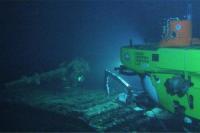 Recently, the crew of the the Hawaii Undersea Research Laboratory‘s submersible Pisces V announced finding the hull of the Japanese mega-submarine I-400 at a depth of 2,300 feet on the sea floor off Hawaii. The huge submarine survived World War II but was scuttled by the United States in the early days of what would become known as the Cold War to prevent the Soviets from gaining access to what was at the time the most advanced submarine technology in the world.
Recently, the crew of the the Hawaii Undersea Research Laboratory‘s submersible Pisces V announced finding the hull of the Japanese mega-submarine I-400 at a depth of 2,300 feet on the sea floor off Hawaii. The huge submarine survived World War II but was scuttled by the United States in the early days of what would become known as the Cold War to prevent the Soviets from gaining access to what was at the time the most advanced submarine technology in the world.
The I-400 was the largest submarine of its day. At 400′ long, the I-400 and its sister vessels would remain the largest submarines ever constructed until the advent of nuclear ballistic missile submarines in the 1960s. The I-400 was also an aircraft carrier, capable of carrying up to three Aichi M6A Seiran bombers in water-tight hangers. The submarines were intended to attack the Panama Canal among other targets. Thee of the huge submarines were built while two others were under construction at the end of the war. All five were brought to Pearl Harbor following Japan’s surrender.
The treaty that ended the war in the Pacific stipulated that any military technology acquired from Japan was to be made available to other Allied powers, including the Soviet Union. With the Cold War heating up, the US decided to scuttle the five submarines rather than give the Soviet Union a look at their technology. The government’s official line, that the five subs had been used for target practice and that the precise locations of the wrecks were unknown.
At least the last portion of the statement turned out to be at least partially true. The location of the scuttled I-400 had been lost. The estimated location turned out to be miles from where the sub was located.
Finding Japan’s Aircraft-Carrier Sub
As for what awaits the I-400, its present resting place will probably be permanent. There are no plans to bring any of the wreckage to the surface.
“In cases like this, when you find historic shipwrecks, what you’ve done is not just something archaeological,” Dr. Delgado said. “You have added into the catalog of the world’s greatest museum: the bottom of the seas.”
Thanks to Irwin Bryan for contributing to this post.

These subs, the I-400 and the I-401 were on either PBS, NOVA, Discovery or one of those channels about a year or two ago.
Interesting what they did and we are lucky they never made it to the west coast.
That television show was the fruit of research done by John Geoghegan, who recently published a book, Operation Storm, that describes Japan’s carrier sub program in great detail. It is a very interesting read:
amazon.com/Operation-Storm-Japans-Secret-Submarines/dp/0307464806
Good day I am so delighted I found your blog page, I really found you by accident,
while I was looking on Google for something else,
Anyways I am here now and would just like to say many thanks for a tremendous post and a all round interesting blog (I also love the theme/design),
I don’t have time to look over it all at the minute but I
have book-marked it and also included your RSS feeds,
so when I have time I will be back to read much more, Please do
keep up the awesome work.